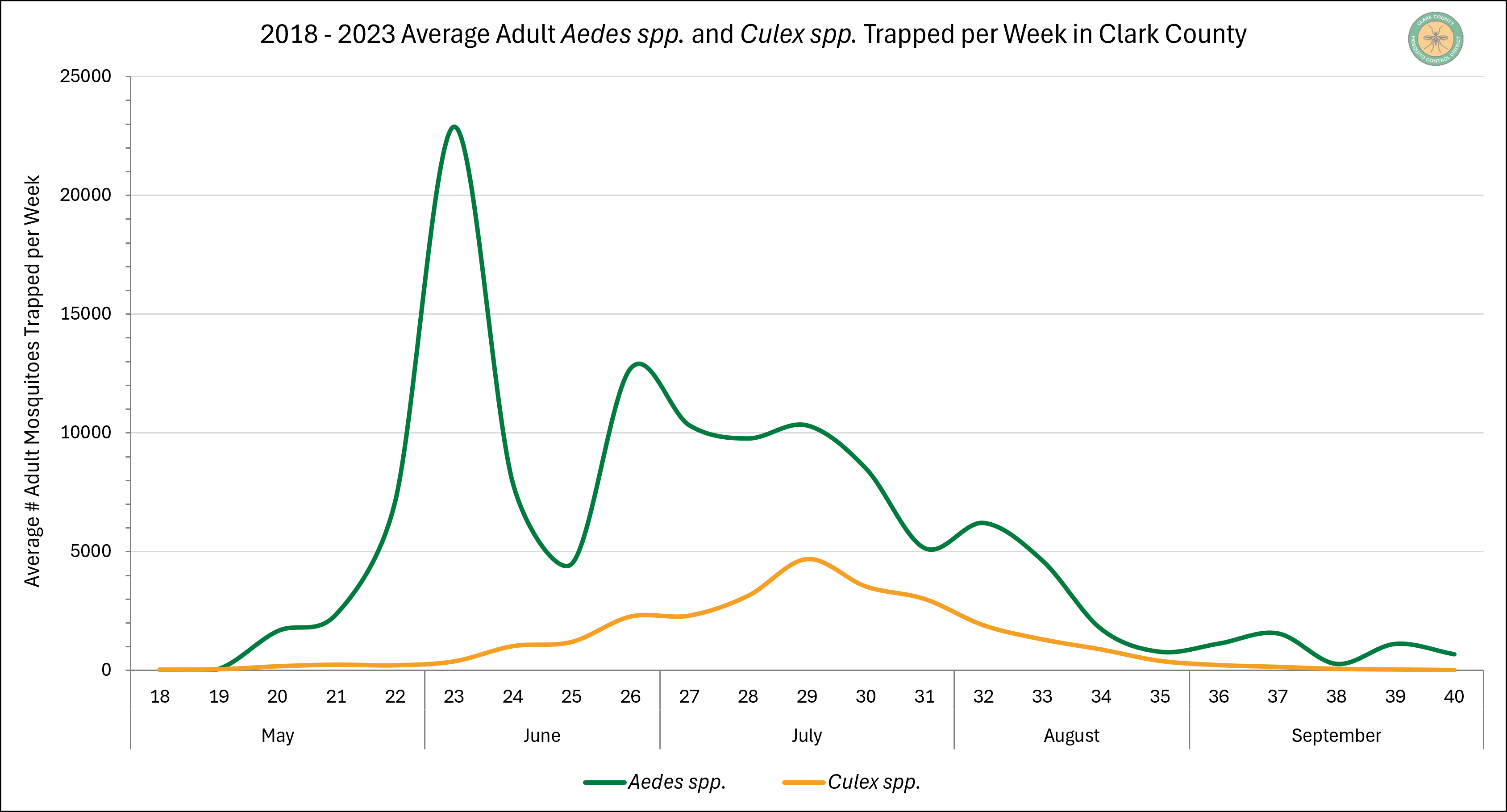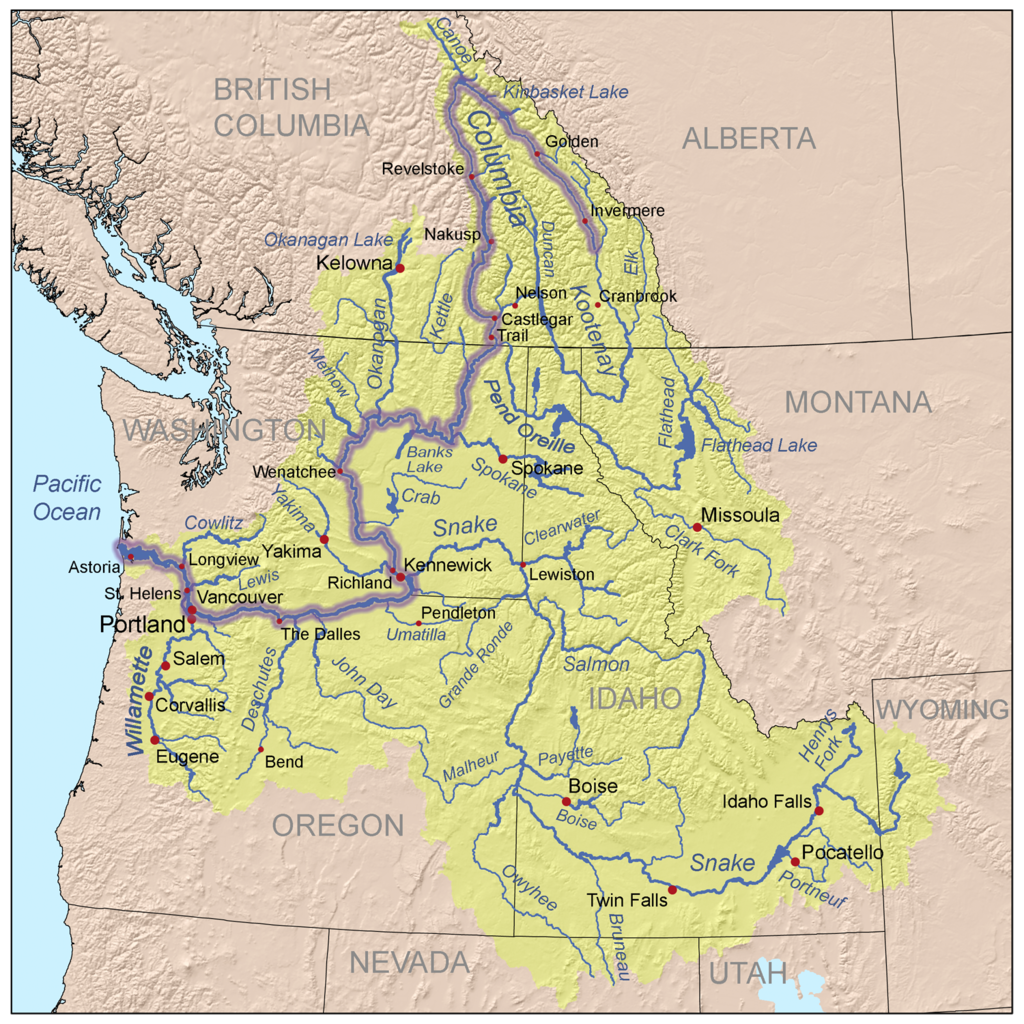Mosquito Behavior
Clark County is home to over 20 different species of mosquitoes, each having a unique life cycle, life span, breeding , resting spaces, and environmental responses. Some mosquitoes are active earlier in the year, such as Aedes, which tend to emerge in peak numbers starting in June. Other groups, such as and Culiseta mosquitoes, won’t often be seen until mid to late summer. While there are general patterns to mosquito species emergence, mosquito larvae ultimately depend on environmental signals to initiate development and emergence. These environmental conditions, such as the presence of water and temperature are highly variable. Environmental conditions can also affect adult mosquitoes after they emerge from the pupal stage. For example, high humidity levels can favor an extended lifespan for adults. As such, the emergence patterns and longevity of different mosquitoes can change slightly from year to year depending on environmental conditions.
Environmental Conditions
Environmental conditions and patterns can play a large role in the density of mosquito populations. Ideal conditions can vary between different mosquito species, but some common factors include the presence of water, levels of dissolved oxygen, and high temperatures.1
For example, 2022 and 2023 produced abundant populations of mosquitoes, likely due to particular weather conditions. In 2022, the Columbia River reached the flood stage when it recorded a maximum height of 16.5 feet. This rise in the river level was due to melting snowpacks and several days of heavy rain in early June. In 2023, the Columbia River reached pre-flood levels when it recorded a maximum height of 13.7 feet in early May, largely due to heavy snow melts. This flooding event coincided with a series of extremely hot days, with peak temperatures reaching 93 °F. The flooding of rivers, and their associated watersheds, can produce an influx of new breeding habitats for mosquitoes, particularly Aedes vexans and Aedes sticticus, also known as the flood-water mosquito.2, 3
Temperature can also have a direct impact on mosquito abundance and development. While there is a general positive association between mosquito abundance and high temperatures and humidity, the relationship between mosquito life cycles and extremely high temperatures is complex.1, 4 For most species, increasing temperatures have also been shown to increase the rate of development at all mosquito life stages, as well as increased rates in feeding activity and survival.1
For more information on the relationship between flooding of the Columbia River and mosquito populations, please read the articles listed below.
Green Spaces for Harborage
The Columbia River drainage basin comprises almost 13,000 miles of river and stream habitats. More than 2,400 miles of those waterways can be found in Clark County.
Green spaces are vegetated areas of land or water within or adjoining an urban area. They naturally form in and around watersheds, where the vegetation often has abundant access to water. Green spaces can provide attractive resting habitats for adult mosquitoes during the day.5 These diurnal resting spaces can include understory vegetation, bushes, tree cavities, and other natural environments.6, 7, 8, 9
Notable Clark County green spaces include more than 6,300 acres of federal wildlife refuge land, 2,600 acres of state wildlife areas, 5,000 acres of county protected land, and 3,800 acres of city managed park lands. Many of the green spaces throughout Clark County have some form of public access. While these natural areas make for great recreation spaces, they can also lead to a higher chance of exposure to mosquitoes.
For more information on the resting behavior of adult mosquitoes, please read the articles listed below.
Additional Resources
Environmental Conditions
1Mosquito abundance in relation to extremely high temperatures in urban and rural areas of Incheon Metropolitan City, South Korea from 2015 to 2020: an observational study
Lim, A.-Y., Cheong, H.-K., Chung, Y., Sim, K., & Kim, J.-H. (2021). Mosquito abundance in relation to extremely high temperatures in urban and rural areas of Incheon Metropolitan City, South Korea from 2015 to 2020: an observational study. Parasites & Vectors, 14(1), 559–10. https://doi.org/10.1186/s13071-021-05071-z
2Studies on Aedes vexans (meig.) and Aedes sticticus (meig.), flood-water mosquitoes, in the Lower Columbia River Valley
Gjullin, C. M., Yates, W. W., & Stage, H. H. (1950). Studies on Aedes vexans (meig.) and Aedes sticticus (meig.), flood-water mosquitoes, in the Lower Columbia River Valley. Annals of the Entomological Society of America, 43(2), 262–275. https://doi.org/10.1093/aesa/43.2.262
3Relation of the Bonneville Dam to mosquito control along the Columbia River
Stage, H. H. (1943). Relation of the Bonneville Dam to mosquito control along the Columbia River. Proceedings New Jersey Mosquito Extermination Association, 30, 197-202.
4Potential effects of heat waves on the population dynamics of the dengue mosquito Aedes albopictus
Jia, P., Liang, L., Tan, X., Chen, J., & Chen, X. (2019). Potential effects of heat waves on the population dynamics of the dengue mosquito Aedes albopictus. PLoS Neglected Tropical Diseases, 13(7), e0007528–e0007528. https://doi.org/10.1371/journal.pntd.0007528
Green Spaces
5Effects of landscape composition on mosquito population in urban green spaces
Zhao, J., Tang, T., & Wang, X. (2020). Effects of landscape composition on mosquito population in urban green spaces. Urban Forestry & Urban Greening, 49, 126626. https://doi.org/10.1016/j.ufug.2020.126626
6Habitat and microclimate affect the resting site selection of mosquitoes
Sauer, F. G., Grave, J., Lühken, R., & Kiel, E. (2021). Habitat and microclimate affect the resting site selection of mosquitoes. Medical and Veterinary Entomology, 35(3), 379–388. https://doi.org/10.1111/mve.12506
7The Daytime Distribution of Mosquitoes Resting in Vegetation
Service, M. W. (1971). The daytime distribution of mosquitoes resting in vegetation. Journal of Medical Entomology, 8(3), 271–278. https://doi.org/10.1093/jmedent/8.3.271
8Preference of Female Mosquitoes for Natural and Artificial Resting Sites
Burkett-Cadena, N. D., Eubanks, M. D., & Unnasch, T. R. (2008). Preference of Female Mosquitoes for Natural and Artificial Resting Sites. Journal of the American Mosquito Control Association, 24(2), 228–235. https://doi.org/10.2987/5662.1
9Studies on the diurnal resting habits of Anopheles albimanus and A. pseudopunctipennis in El Salvador
Breeland, S.G. (1972) Studies on the diurnal resting habits of Anopheles albimanus and A. pseudopunctipennis in El Salvador. Mosquito News, 32, 99–106.
Further reading
The effect of global change on mosquito-borne disease
Franklinos, L. H. V., Jones, K. E., Redding, D. W., & Abubakar, I. (2019). The effect of global change on mosquito-borne disease. The Lancet Infectious Diseases, 19(9), e302–e312. https://doi.org/10.1016/S1473-3099(19)30161-6
Potential effects of heat waves on the population dynamics of the dengue mosquito Aedes albopictus
Jia, P., Liang, L., Tan, X., Chen, J., & Chen, X. (2019). Potential effects of heat waves on the population dynamics of the dengue mosquito Aedes albopictus. PLoS Neglected Tropical Diseases, 13(7), e0007528–e0007528. https://doi.org/10.1371/journal.pntd.0007528
Climate change: an enduring challenge for vector-borne disease prevention and control
Rocklöv, J., & Dubrow, R. (2020). Climate change: an enduring challenge for vector-borne disease prevention and control. Nature Immunology, 21(5), 479–483. https://doi.org/10.1038/s41590-020-0648-y

